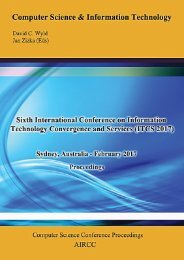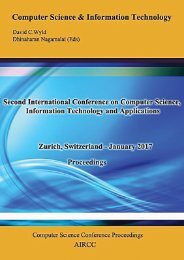CoSIT 2017
Fourth International Conference on Computer Science and Information Technology ( CoSIT 2017 ), Geneva, Switzerland - March 2017
Fourth International Conference on Computer Science and Information Technology ( CoSIT 2017 ), Geneva, Switzerland - March 2017
Create successful ePaper yourself
Turn your PDF publications into a flip-book with our unique Google optimized e-Paper software.
40 Computer Science & Information Technology (CS & IT)<br />
primitives. This idea was central to the work of Marr [3]. Shape learning may then be<br />
decomposed into a two-stage process. The first stage is to acquire a models of the variability is<br />
the distinct primitives. The second stage is to learn the arrangements of the primitives<br />
corresponding to different shape classes.<br />
Although this structural approach has found widespread use in the character recognition<br />
community, it has not proved popular in the computer vision domain. The reason for this is that<br />
the segmentation of shapes into stable primitives has proved to be an elusive problem. Hence,<br />
there is a considerable literature on curve polygonalisation, segmentation and grouping. However,<br />
one of the reasons that the structural approach has proved fragile is that it has been approached<br />
using geometric rather than statistical methods. Hence, the models learned and the recognition<br />
results obtained are highly sensitive to segmentation error. In order to overcome these problems,<br />
in this paper we explore the use of probabilistic framework for recognition.<br />
We focus on the problem of developing hierarchical shape models for handwritten Arabic<br />
characters. These characters are decomposed into concave or convex strokes. Our statistical<br />
learning architecture is reminiscent of the hierarchical mixture of experts algorithm. This is a<br />
variant of the expectation maximisation algorithm, which can deal with hierarchically structured<br />
models. The method was first introduced in 1994 by Jordan and Jacobs [4]. In its simplest form<br />
the method models data using a doubly nested mixture model. At the top layer the mixture is over<br />
a set of distinct object classes. This is sometimes referred to as the gating layer. At the lower<br />
level, the objects are represented as a mixture over object subclasses. These sub-classes feed into<br />
the gating later with predetermined weights. The parameters of the architecture reside in the<br />
sublayer, which is frequently represented using a Gaussian mixture model. The hierarchical<br />
mixture of experts algorithm provides a means of learning both the gating weights and the<br />
parameters of the Gaussian mixture model.<br />
Here our structural decomposition of 2D shapes is a hierarchical one which mixes geometric and<br />
symbolic information. The hierarchy has a two-layer architecture. At the bottom layer we have<br />
strokes or curve primitives. These fall into different classes. For each class the curve primitive is<br />
represented using a point-distribution model [5] which describes how its shape varies over a set<br />
of training data. We assign stroke labels to the primitives to distinguish their class identity. At the<br />
top level of the hierarchy, shapes are represented as an arrangement of primitives. The<br />
representation of the arrangement of primitives has two components. The first of these is a second<br />
point distribution model that is used to represent how the arrangement of the primitive centrepoints<br />
varies over the training data. The second component is a dictionary of configurations of<br />
stroke labels that represents the arrangements of strokes at a symbolic level. Recognition hence<br />
involves assigning stroke symbols to curves primitives, and recovering both stroke and shape<br />
deformation parameters. We present a probabilistic framework which can be for the purposes of<br />
shape-recognition in the hierarchy. We apply the resulting shape-recognition method to Arabic<br />
character recognition.<br />
2. SHAPE REPRESENTATION<br />
ρ ρ<br />
We are concerned with recognising a shape W { w ,..., w }<br />
=<br />
1 p<br />
ordered but unlabelled landmark points with 2D co-ordinate vectors w ρ 1<br />
, ....,<br />
which consists of a set of p<br />
w ρ p<br />
. The shape is<br />
assumed to be segmented into a set of K non-overlapping strokes. Each stroke consists of a set





